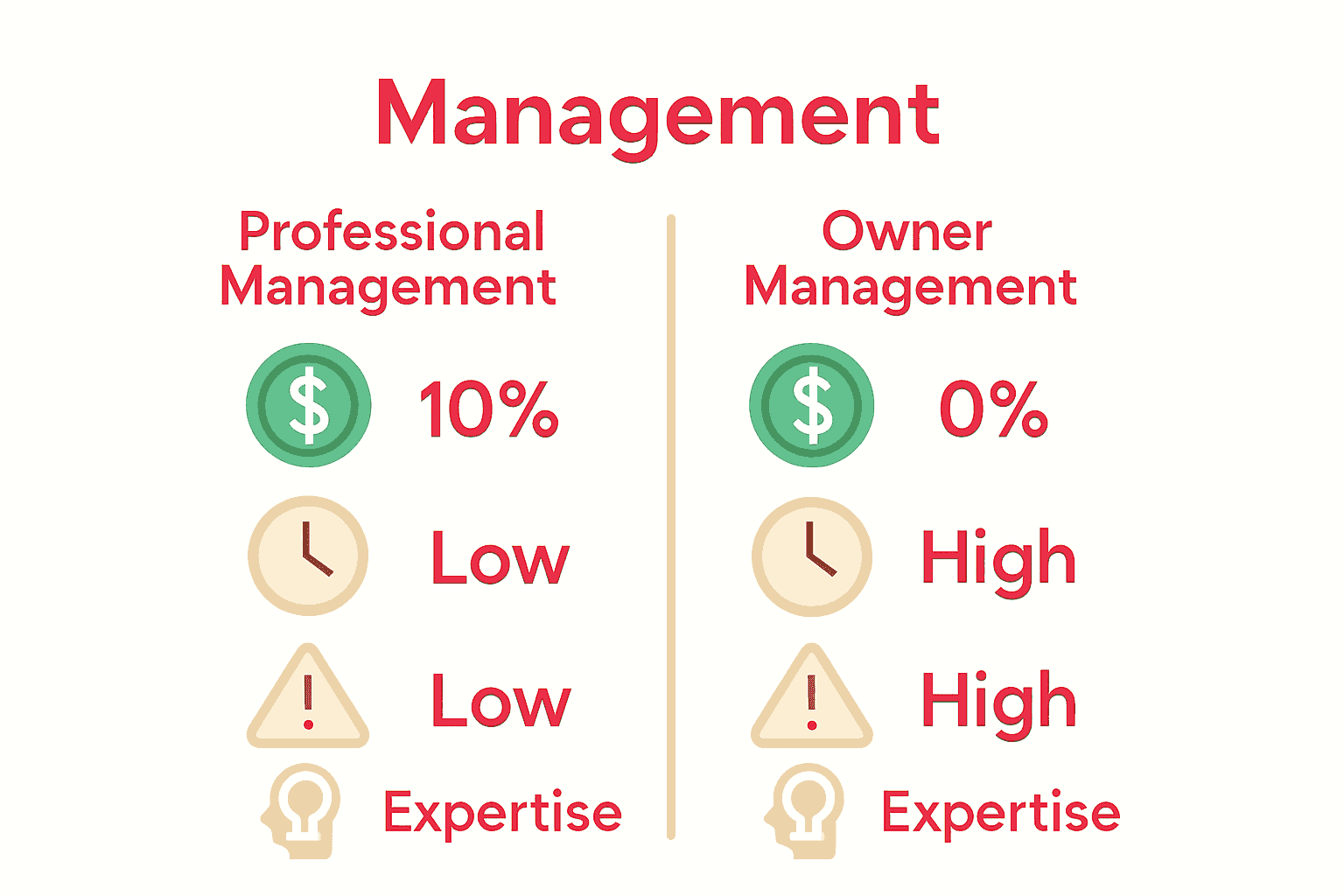Nearly 1 in 3 property owners underestimate the true financial outlay of professional property management. These costs impact rental income, property value, and even long-term investment goals. Understanding what goes into property management fees can help you make smarter decisions, avoid surprise expenses, and ensure your real estate investment stays profitable. Get the facts you need so you can protect your bottom line and maximize returns.
Table of Contents
- What Property Management Cost Means
- Types of Property Management Fee Models
- Services Included in Management Costs
- Legal and Contractual Owner Obligations
- Comparing Costs Versus Owner Management
- Hidden Fees and Cost-Saving Tips
Key Takeaways
| Point | Details |
|---|---|
| Understanding Property Management Costs | Involves operational management, tenant relations, and financial administration, with fees typically ranging from 8-12% of rental income. |
| Types of Fee Models | Key models include percentage-based, flat rate, hybrid, and per-service fees, each offering unique advantages and challenges for property owners. |
| Services Included | Comprehensive property management services cover tenant management, financial administration, and maintenance, allowing owners to outsource complex tasks. |
| Comparing Management Approaches | Professional management can optimize returns despite associated fees, while self-management may incur hidden costs and require significant personal time investment. |
What Property Management Cost Means
Property management cost represents the comprehensive financial investment associated with professionally overseeing and maintaining real estate assets. According to INREV, these costs encompass multiple strategic components beyond simple maintenance, including operational management, financial administration, tenant relations, and performance optimization.
Typically, property management costs are structured through several key fee models:
- Base Management Fee: A standard percentage of collected rental income (usually 8-12%)
- Leasing Fee: Charged when securing new tenants or renewing existing agreements
- Maintenance Reserve: Funds allocated for routine and emergency property repairs
- Performance Incentive Fee: Additional compensation based on exceeding specific financial benchmarks
As JLL highlights, these fee structures can vary significantly depending on property type, location, and management complexity. Professional property managers aim to balance cost-effectiveness with high-quality service, ensuring properties remain financially productive while meeting tenant expectations.
Understanding these costs is crucial for property owners seeking predictable income streams and minimized operational risks. Learn more about property management fees in our comprehensive guide.
Types of Property Management Fee Models
Property management fee models vary significantly, reflecting the diverse strategies used by professional property managers to align compensation with service delivery. According to INREV, these models are structured to balance operational complexity, risk management, and financial incentives across different property types and investment scenarios.
The primary property management fee models include:
- Percentage-Based Fee Model: Calculated as a percentage of monthly rental income (typically 8-12%)
- Flat Rate Fee Model: A fixed monthly charge regardless of property performance
- Hybrid Fee Model: Combines base percentage with performance-based incentives
- Per-Service Fee Model: Charges for specific services like tenant screening, maintenance coordination, or lease management
Each fee model offers distinct advantages and challenges for property owners.
The percentage-based model aligns management interests with property performance, while flat-rate models provide predictable costs. Performance-driven models can incentivize managers to maximize occupancy and minimize vacancies, creating a more dynamic management approach.
Here’s a summary of the main property management fee models and their characteristics:
| Fee Model | How It’s Charged | Advantages | Challenges |
|---|---|---|---|
| Percentage-Based | 8-12% of rental income | Aligns interests Performance-based |
Costs rise with income |
| Flat Rate | Fixed monthly charge | Predictable expense | May lack performance incentive |
| Hybrid | Base fee plus incentive | Rewards strong results | Complex structure |
| Per-Service | Charged for each service | Pay for what you use | Unpredictable total cost |
Choosing the right fee model depends on property characteristics, owner expectations, and market dynamics. Explore our guide on revenue models for property owners to understand how different fee structures can impact your investment strategy and potential returns.
Services Included in Management Costs
Property management services encompass a comprehensive range of responsibilities designed to maximize property performance and tenant satisfaction. According to INREV, these services typically extend far beyond basic maintenance, providing property owners with a holistic approach to asset management.
Key services typically included in management costs are:
-
Tenant Management:
- Screening and selection of qualified tenants
- Lease negotiation and documentation
- Rent collection and payment processing
- Handling tenant communications and complaints
-
Financial Administration:
- Monthly and annual financial reporting
- Expense tracking and budgeting
- Tax preparation assistance
- Detailed income and expenditure statements
-
Maintenance and Repairs:
- Routine property inspections
- Coordinating emergency and preventative maintenance
- Managing vendor relationships
- Ensuring compliance with safety and building regulations
The comprehensive nature of these services means property owners can essentially outsource the complex operational aspects of property ownership. Professional managers act as a buffer between owners and potential challenges, transforming what could be a time-consuming investment into a more streamlined and predictable revenue stream.

Learn more about how property management services can optimize your real estate investment through strategic, professional oversight.
Legal and Contractual Owner Obligations
Property ownership involves a complex web of legal and contractual responsibilities that extend far beyond simple asset management. According to INREV, these obligations encompass a comprehensive framework of regulatory compliance, financial transparency, and risk management that property owners must carefully navigate.
Key legal and contractual obligations typically include:
-
Regulatory Compliance:
- Adherence to local housing and property regulations
- Maintaining required safety and building standards
- Ensuring proper licensing and permits
- Compliance with tenant protection laws
-
Financial Transparency:
- Accurate and timely financial reporting
- Transparent fee structures and cost breakdowns
- Proper tax documentation and filing
- Maintaining comprehensive financial records
-
Risk Management:
- Adequate property insurance coverage
- Implementing risk mitigation strategies
- Addressing potential legal liabilities
- Protecting against potential tenant disputes
As JLL emphasizes, successful property ownership hinges on understanding and proactively managing these contractual obligations. Property owners must approach these responsibilities with diligence, seeking professional guidance to navigate the intricate legal landscape effectively.
Discover more about property management legal considerations in our comprehensive guide to ensure you’re fully prepared for your investment journey.
Comparing Costs Versus Owner Management
Navigating the financial landscape of property management requires a critical examination of professional management versus self-management strategies. According to INREV, the true cost of property management extends far beyond simple monetary calculations, encompassing time investment, expertise, and potential opportunity costs.
Key comparative considerations include:
-
Direct Financial Costs:
- Professional Management: Typically 8-12% of monthly rental income
- Owner Management: No direct management fees, but hidden operational expenses
- Potential cost savings through professional economies of scale
-
Time Investment:
- Professional Management: Minimal owner involvement
- Owner Management: Significant personal time commitment
- Estimated value of owner’s time: 10-20 hours per month per property
-
Expertise and Risk Mitigation:
- Professional Managers: Specialized legal and market knowledge
- Owner Management: Limited understanding of complex regulations
- Potential cost of legal mistakes or compliance issues
While professional management involves direct fees, the strategic benefits often outweigh the costs. Professional managers can optimize rental rates, reduce vacancy periods, and minimize potential legal and financial risks that could prove substantially more expensive for individual owners.

Explore our comprehensive guide on maximizing property investment returns to understand the nuanced financial strategies in property management.
Hidden Fees and Cost-Saving Tips
Property management fee structures can be complex and riddled with potential unexpected expenses. According to INREV, property owners must meticulously scrutinize management agreements to identify and mitigate potential hidden costs that can significantly impact overall investment returns.
Common hidden fees to watch for include:
-
Maintenance and Repair Fees:
- Markup on contractor services
- Administrative charges for coordinating repairs
- Minimum service call charges
- Percentage-based repair cost surcharges
-
Leasing and Turnover Expenses:
- Tenant placement fees
- Marketing and advertising costs
- Inspection and cleaning charges between tenants
- Lease renewal processing fees
-
Administrative and Miscellaneous Charges:
- Document processing fees
- Communication and postage expenses
- Software or technology access charges
- Accounting and financial reporting fees
Cost-saving strategies involve proactive contract negotiation, clear communication, and understanding exactly what services are included in your management agreement. Property owners can potentially reduce expenses by requesting transparent fee structures, negotiating flat rates for specific services, and establishing clear performance expectations.
Learn more about optimizing your property management investment with our comprehensive revenue guide to make informed financial decisions.
Take Control of Your Property Management Costs with Guestly Homes
Managing property costs while maintaining high service quality is a challenge many property owners face, as detailed in the “Property Management Cost: Complete Guide for 2025.” The complexity of fee models, hidden charges, and legal obligations can be overwhelming. At Guestly Homes we understand that you want predictable income, hands-off management, and transparent partnerships that align with your financial goals.

Explore how Guestly Homes offers premium fully managed solutions that transform your property into a thriving, hassle-free investment. Whether you prefer our Revenue Share Model for performance-driven growth or the Arbitrage Model for stable fixed income, we deliver consistent standards with hotel-grade quality across Sweden and the Nordics. Discover the benefits of seamless property performance, clear contracts, and expert oversight designed to reduce risks and hidden fees. Take the next step towards smarter property management by visiting Guestly Homes and learn more about how we help owners achieve long-term profitability with ease. Your investment deserves a partner that works quietly and efficiently – start the conversation today.
Learn more about optimising your property revenue in our revenue models guide and find out why working with a 5-star operator matters by reading what is a property management company.
Frequently Asked Questions
What are the primary components of property management costs?
Property management costs generally include a base management fee, leasing fees, maintenance reserves, and potential performance incentive fees, which together cover the financial investment in managing a property.
How do property management fee models differ?
Property management fee models can be percentage-based, flat rate, hybrid, or per-service. Percentage-based models charge a percentage of rental income, while flat rates provide a fixed monthly cost, and hybrid models combine these with performance incentives.
What services are commonly included in property management costs?
Typical services included in property management costs are tenant management, financial administration, and maintenance and repairs, which together enhance property performance and tenant satisfaction.
How can property owners identify hidden fees in management agreements?
Property owners should carefully review management agreements for hidden fees related to maintenance, leasing, and administrative charges. Strategies to avoid these include negotiating contract terms and ensuring transparency in the fee structure.
Recommended
- What Do You Need to Become a Property Manager in 2025? – Guestly Homes
- The Ultimate Guide to Cost Rentals for Beginners 2025 – Guestly Homes
- Property Management Software: Complete Guide for 2025 – Guestly Homes
- The Ultimate Guide to Premier Housing for Beginners (2025) – Guestly Homes
- 7 Essential EPC Compliance Tips for London Property Owners – Complete EPC
- Как да изчислим рентабилността на нашия имот



